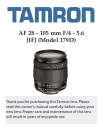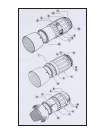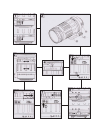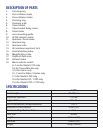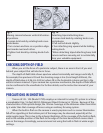
Fig. 9
Altering camera between vertical & horizon-
tal positions
1. Loosen lock knob by rotating knob coun-
terclockwise.
2. Turn camera and lens so as position align-
ment marks meet each other.
3. Tighten lock knob by rotating knob clock-
wise.
Fig. 10
Detaching tripod-attaching base
1. Loosen lock knob by rotating knob coun-
terclockwise.
2. Pull out lock knob slightly.
3. Turn attaching ring upward while holding
locking knob.
* When detaching tripod-attaching base, hold
camera and lens securely, not to accidentally
drop your valuable equipment.
CHECKING DEPTH-OF-FIELD
When you set the focus of a particular subject, there is an area in front of you and
behind your subject that will also be in focus.
The depth-of-field table shows aperture values horizontally and ranges vertically. If,
for example, the aperture is F8 and the shooting range is 5m (Focal length 400mm), the
depth-of-field value is 4.96 (m)-5.04 (m) where F8 in the horizontal column and 5m in the
vertical column intersect. If your camera has a preview mechanism, the depth-of-field effect
can be confirmed in the viewfinder. For further details, see the instruction manual of your
camera.
PRECAUTIONS IN SHOOTING
Tamron AF 28 - 105 (Model 179D) employs an internal Focusing (IF) system to achieve
a remarkable 0.5m (1.6 feet) M.O.D. (Minimum Object Distance) at 105mm. Because of the
characteristics of this optical design, the 105mm coverage, at the distances other than infini-
ty, is wider than that coverage of lenses using an ordinary focusing system.
When the built-in flash on the camera is used, symptoms such as corner illumination
fall-off or vignetting at the bottom part of the image may be observed, especially at the
wider-angle range.This is due to the inherent limitation of the coverage of the built-in flash,
and/or the relative position of the flash to the edge of the lens barrel, which causes shad-
ows on the image. Accordingly, we recommend not using the built-in flash at wider-angle
settings.



